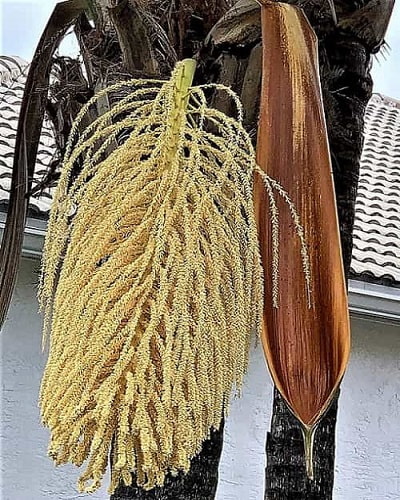- Home
- How Palms Grow
- Dio to Mono Difference
Dioecious VS Monoecious in the Plant World
Dioecious vs monoecious is a comparison you'll discover!
When you're looking into the world of plant biology. It helps to understand the difference when you're getting into the "nitty-gritty" of palms. Because a palm can be dioecious or monoecious.
With plant reproduction, there are the two main categories of plants and their flowers: dioecious and monoecious. Understanding those differences can help you better understand the way each of them start their growth. That each have different patterns to follow.
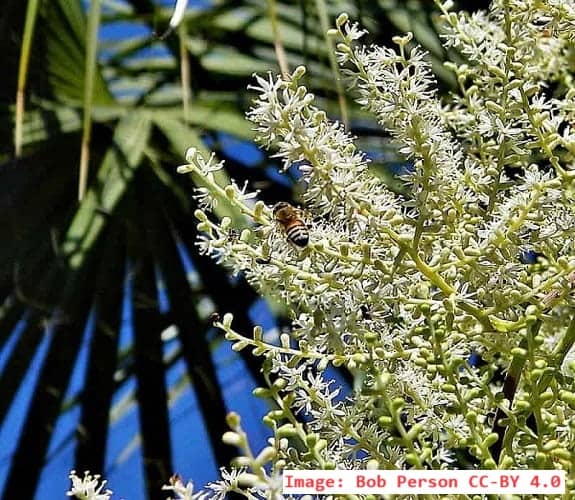 Bee Helping Pollinate a Cabbage Palm (Sabal palmetto).
Bee Helping Pollinate a Cabbage Palm (Sabal palmetto).One of the monoecious Palms With Bisexual Flowers.
Look Closely - You'll See a Few Other Insects, Too!
At Mission: Palm Trees
Palm lovers can soothe their palm-related searches and concerns. Our articles are intended to inform, while having fun, easily Finding What You Want or Need. Without unneeded shoptalk & tiring endless research. We Research For You!
Basic Understanding of Dioecious vs Monoecious Plants
These words, monoecious & dioecious, mainly refer to where the different gender flowers of a species grow on plants.
Flowers are the sex life of monoecious & dioecious plants. Flowers carry the sexual reproductive parts of plants. There are reproductive workings that are unique to each, in the dioecious vs monoecious plant worlds.
We'll go a little deeper into this dioecious vs monoecious subject to discover the differences. For better understanding. Let's figure out these main characteristics of dioecious vs monoecious, and why or if it matters!
What are Monoecious Plants?
Have you ever heard that palms are monoecious?
Think of the term mon (or the similar, more often seen: mono), which is from the ancient Greek, meaning single or alone. Essentially referring to one.
Then add in the Greek word for house, oîk (os). Get the Latin combining letters "i" & "e" in there. End it with the Latin suffix "ous."
Put together you have the term monoecious. Which strictly means One House. Using house as referring to where plants live, how they live. Especially where the flowers grow.
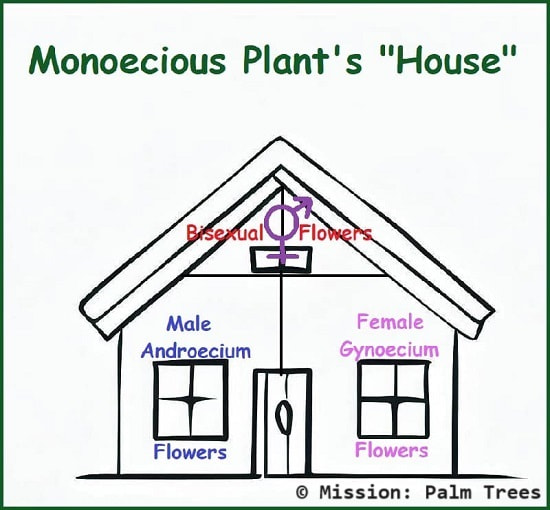
Monoecious plants reproduce in their own unique way. The majority of vegetation in the plant kingdom is monoecious, approximately 90 to 95%.
Types of Monoecious Flowers
Flowers Can Be Unisexual.
Meaning they only have either male or female "body" parts. In plant biology, they call this imperfect or incomplete.
Meaning they only have one of the possible reproductive parts in the flower.
- Male reproductive characteristics are termed androecium.
- Female reproductive characteristics are termed gynoecium.
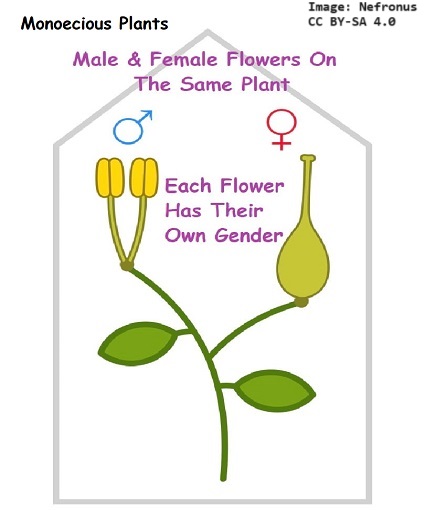
Flowers Can Be Bisexual.
Meaning they have both male & female "body" parts. In plant biology, they call this perfect.
They also refer to these plants/flowers as hermaphrodites.
- Bisexual Flowers have androecium & gynoecium systems on the same flower. This is rare in the palm tree world.
- Can self-plant pollination then happen?
- Technically it's possible. Yet cross-pollination is better for the health & strength of fruit/seeds produced.
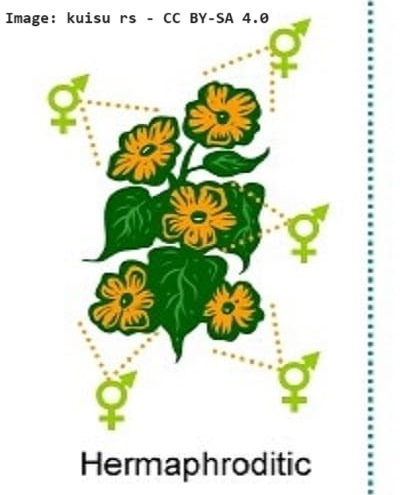 Each Flower Has Male & Female Organs
Each Flower Has Male & Female Organs- Therefore, plant evolution has promoted cross-pollination. Diversity for improvement. Over the years techniques emerged for attracting insects. To carry pollen to flowers on different plants.
Those Monoecious Palms
Monoecious palms have both male & female unisexual (imperfect) flowers. They will be on the same plant. But arranged in different ways:
- Usually male & female flowers grow on the same flower stalk (called the inflorescence). With a bit of spacing between the flowers of different genders.
- Most often, male & female flowers have different time-frames for blooming. This helps with plant species diversity.
- Much less often, male or female palm flowers are set apart. Each onto their own inflorescence. Males on their own inflorescences, & females on their own inflorescences.
Think of a monoecious plant's flower, such as with a palm. It's possible for one flower to have its pollen transferred from another flower on that same palm plant. But that's not ideal for plant diversity.
When the flower is fertilized, it begins the process of forming a fruit. Which contains the seed.
Other monoecious examples are orchids, corn, bananas & grasses.
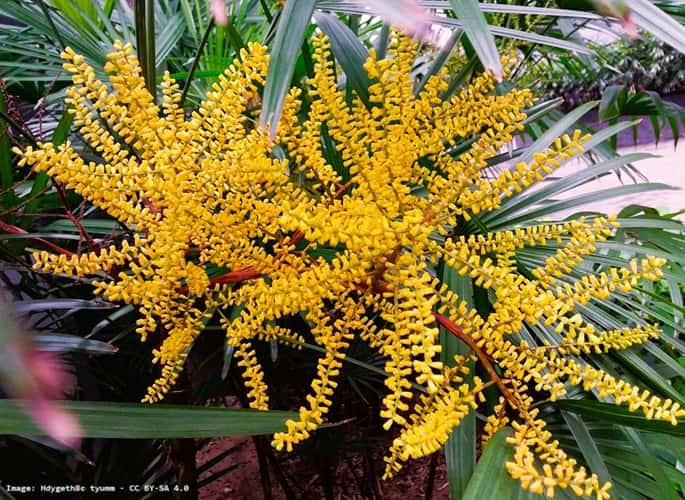 A dioecious Lady Palm (Rhapis excelsa) with its unisexual flowers blooming.
A dioecious Lady Palm (Rhapis excelsa) with its unisexual flowers blooming.Then What are Dioecious Plants?
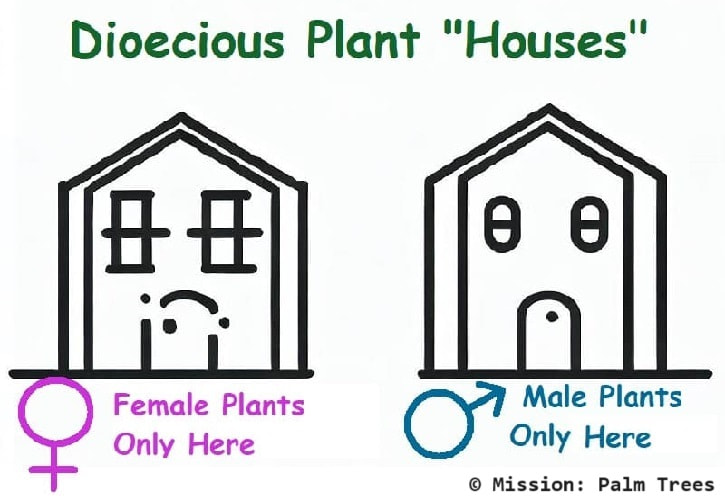
Dioecious plants have separate male and female plant individuals. The term dioecious comes from two Greek words which together mean "two houses."
This means some plants in a species only produce male flowers, while others in the species only produce female flowers. Does that make forming flowers & fruit a bit more complicated? Hmmm...
When you see a dioecious plant, it will either have male flowers or female flowers. This has people calling them a Male Tree or a Female Tree. Being one or the other, not a mixture of both. Depending on which types of flowers they have.
Palms can also be dioecious.
Our Dioecious Experience
This plant category can come in handy, for certain types of landscaping.
For instance our HOA, here in our subdivision, only has specific trees for allowable planting in community yards. Mostly for water conservation, as their approval aligns with our county's "Low Water and Drought Tolerant Plant List."
Promoted all around our county, since We Live in the Desert.
When we first purchased & moved into our house, there was what looked like a very nice tree in the front yard. We quickly discovered the problem with it. Always shedding stuff! Multiple leaves, twigs, branches & more - constantly. When it was flowering time, add them in.
Then getting nasty HOA letters telling us to remove the tree litter. Even though we'd do that all the time. In normal living, it was impossible to keep up with!
 We Took Out That Tree! It Was Worth It.
We Took Out That Tree! It Was Worth It.It had such prolific shedding, we'd have to be on top of it 3X/day - Or more! No time or desire for that, thank you. We kept up as best as we could. But it was so tiring & tedious...
We had it taken out, replacing it with a nice dioecious hybrid male tree called a Red Push Pistache. A Chinese Pistache relation. It doesn't shed & doesn't produce fruit. It's deciduous, only shedding its leaves once a year.
Other examples of dioecious plants are holly, willows, and asparagus plants.
"Sex Life" of Dioecious vs Monoecious Plants
Flowering plants are scientifically called angiosperms. (As opposed to gymnosperms, which produce exposed seeds for direct reproduction. Think of a pine.) Angiosperms are then divided into these two divisions, dioecious & monoecious. Flowers are the parts of angiosperms that produce attractable features to help reproduction happen.
Sort-of like with humans, flowers are fixed up (biologically) to promote sex attractiveness! But with flowers, they don't directly attract each other - as with humans. They attract helpers as go-betweens.
If angiosperm plant reproduction is going to happen, a certain event must occur. Pollen from male flowers must somehow get transferred over to female flowers.
But it doesn't happen by magic! Sort-of. It is a magical process, in a way, though. Dioecious plants depend on the help of wind, insects, or other inadvertent helpers for their pollination. Monoecious plants also are pollinated with those same helpers.
Maybe You Have Helped!
Have you ever walked among bunches of brush, with bushy plants touching your legs & sides? (They're maybe even considered weeds!) Or through a field of flowers?
At certain times of the year. Especially springtime. You may find some yellowish dusty stuff on your jeans! You might have inadvertently been part of the plants' sex life!! Their helper. Whoa, you say!

Yes, you may have pollinated some of these plants.
When brushing against the female individuals, your jeans collected some of the pollen. Then you walked by some of the males (and didn't even realize that!!). Casually brushing the pollen onto the female flowers.
Starting possible new life. Without even being aware of it.
Takeaway for dioecious vs monoecious Plants
In the end, it's often important for farmers, but also for gardeners, to understand differences of dioecious vs monoecious plants.
These differences can affect the way we all manage plants & crops.
However, Plantura Magazine said it in a very good way. They said, "categorising plants as monoecious, dioecious or hermaphroditic is simply an attempt by botanists to identify a system in the variability of nature. But no botanical system fits reality like a glove and there are, as always, exceptions that prove the rule. Mixed forms often occur."
Something to remember, and so not become overly focused on dioecious vs monoecious.
